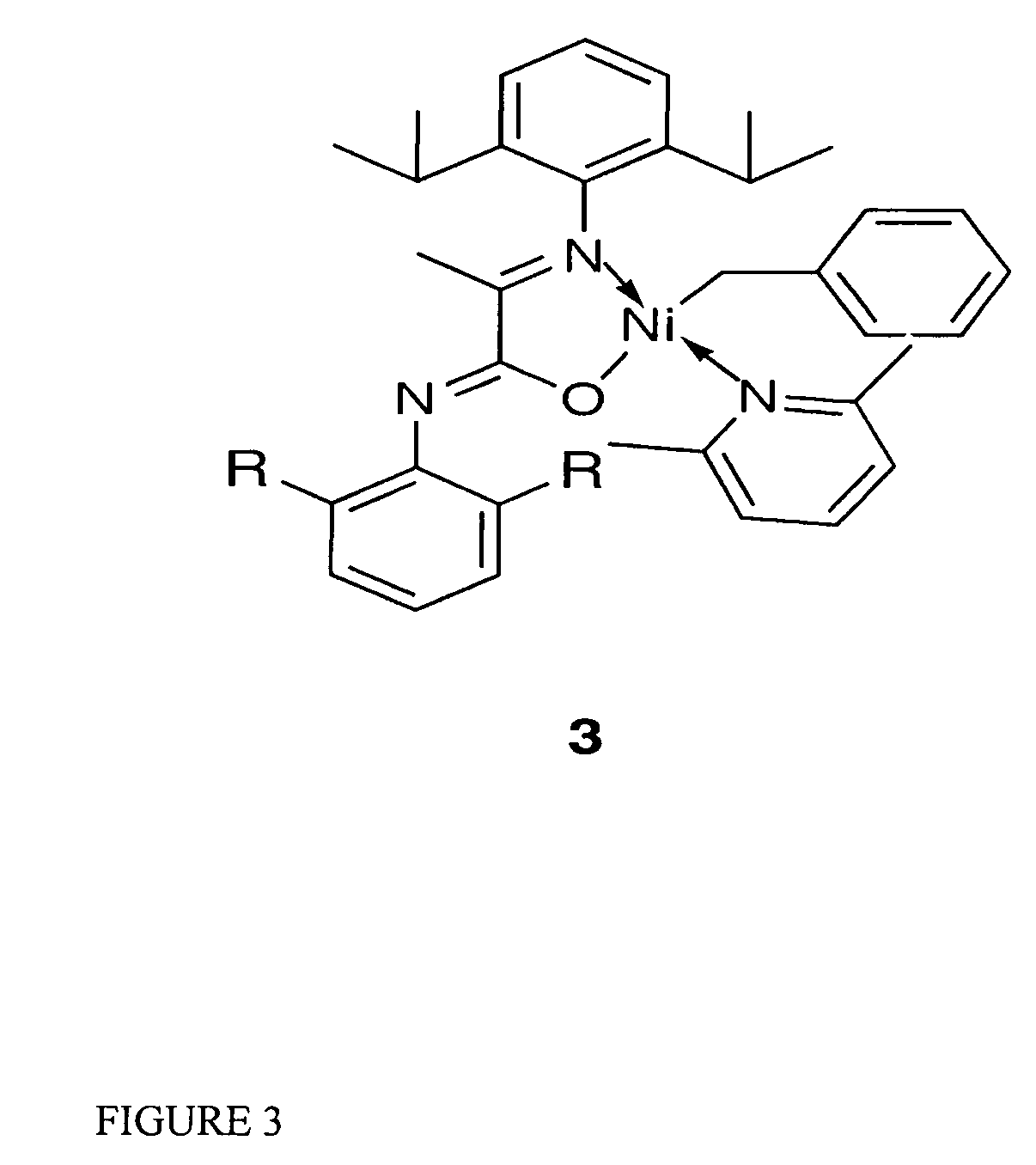Single component, phosphine-free, initiators for ethylene homopolymerization and copolymerization with functionalized co-monomers
a functionalized monomer and ethylene homopolymer technology, applied in the direction of physical/chemical process catalysts, group 8/9/10/18 element organic compounds, chemical/physical processes, etc., can solve the problems of reducing the utility of methylaluminoxane activated catalysts, prone to induction period, and thermal instability of catalyst systems, etc., to increase the utility of these materials and enhance properties
- Summary
- Abstract
- Description
- Claims
- Application Information
AI Technical Summary
Benefits of technology
Problems solved by technology
Method used
Image
Examples
example 1
Catalytic initiator 1: N-(2,6-Diisopropylphenyl)-2-(2,6-diisopropylphenylimino)propanamidato-κ2N,O(η1-CH2Ph)nickel(pyridine)
[0055]
[0056]The synthesis of initiator 1 was carried out under an inert atmosphere with minimal exposure to light. A Ni(COD)2 solution (68 mg, 0.25 mmol in 5 mL of THF) was treated with a mixture of benzyl chloride (63 mg, 0.63 mmol) and pyridine (234 mg, 2.96 mmol) in 2 mL of THF at 35° C. or ambient temperature. The potassium salt of the ligand (108 mg, 0.24 mmol, dissolved in 3 mL of THF) was added after 10 minutes. The reaction mixture was allowed to warm up to room temperature and was stirred overnight, volatiles were then removed under vacuum. The resulting oil was extracted with ether (15 mL) and filtered. Initiator 1 was isolated from the first crystallization batch as dark orange crystals in 62% yield. 1H NMR spectroscopy showed 2 isomers in a 3:1 ratio, which are positional isomers having N,O ligand coordination with the benzyl group positioned either...
example 2
Catalytic initiator 2: [N-(2,6-Diisopropylphenyl)-2-(2,6-diisopropylphenylimino)propanamidato-κ2N,O](η1CH2Ph)nickel(2,6-dimethylpyridine)
[0059]
[0060]The synthesis of initiator 2 was carried out under an inert atmosphere with minimal exposure to light. A Ni(COD)2 solution (68 mg, 0.25 mmol in 5 mL of THF) was treated with a mixture of benzyl chloride (63 mg, 0.63 mmol) and lutidine (156 mg, 1.45 mmol) in 2 mL of THF at 35° C. or ambient temperature. The potassium salt of the ligand (108 mg, 0.24 mmol, dissolved in 3 mL of THF) was added after 10 minutes. The reaction mixture was allowed to warm up to room temperature and was stirred overnight, volatiles were then removed under vacuum. The resulting oil was extracted with ether (15 mL) and filtered. The solvent volume was reduced and crystallization took place at room temperature overnight. Compound 2 was isolated from the first crystallization batch, as dark orange crystals in 71% yield.
[0061]1H-NMR spectroscopy showed a single isome...
example 3
Catalytic initiator 3: [N-(2,6-Diisopropylphenyl)-2-(2,6-3,5-bisfluoromethylphenylimino) propanamidato-κ2N,O](η1-CH2Ph)nickel(2,6-dimethylpyridine)
[0063]
[0064]The synthesis of initiator 3 was carried out under an inert atmosphere with minimal exposure to light. A Ni(COD)2 solution (68 mg, 0.25 mmol in 5 mL of THF) was treated with a mixture of benzyl chloride (63 mg, 0.5 mmol) and lutidine (160 mg, 1.48 mmol) in 2 mL of THF at ambient temperature. The potassium salt of the ligand (108 mg, 0.23 mmol, dissolved in 3 mL of THF) was added after 5 minutes. The reaction mixture was stirred overnight, volatiles were then removed under vacuum. The resulting oil was extracted with ether (15 mL) and filtered. The solvent was removed by vacuum. Pentane was added and crystallization took place at room temperature for 4 hours. initiator 3 was isolated from the first crystallization batch, as dark orange crystals in 50% yield. Single crystals of initiator 3 suitable for X-ray diffraction studies ...
PUM
| Property | Measurement | Unit |
|---|---|---|
| temperatures | aaaaa | aaaaa |
| temperature | aaaaa | aaaaa |
| volume | aaaaa | aaaaa |
Abstract
Description
Claims
Application Information
 Login to View More
Login to View More - R&D
- Intellectual Property
- Life Sciences
- Materials
- Tech Scout
- Unparalleled Data Quality
- Higher Quality Content
- 60% Fewer Hallucinations
Browse by: Latest US Patents, China's latest patents, Technical Efficacy Thesaurus, Application Domain, Technology Topic, Popular Technical Reports.
© 2025 PatSnap. All rights reserved.Legal|Privacy policy|Modern Slavery Act Transparency Statement|Sitemap|About US| Contact US: help@patsnap.com



